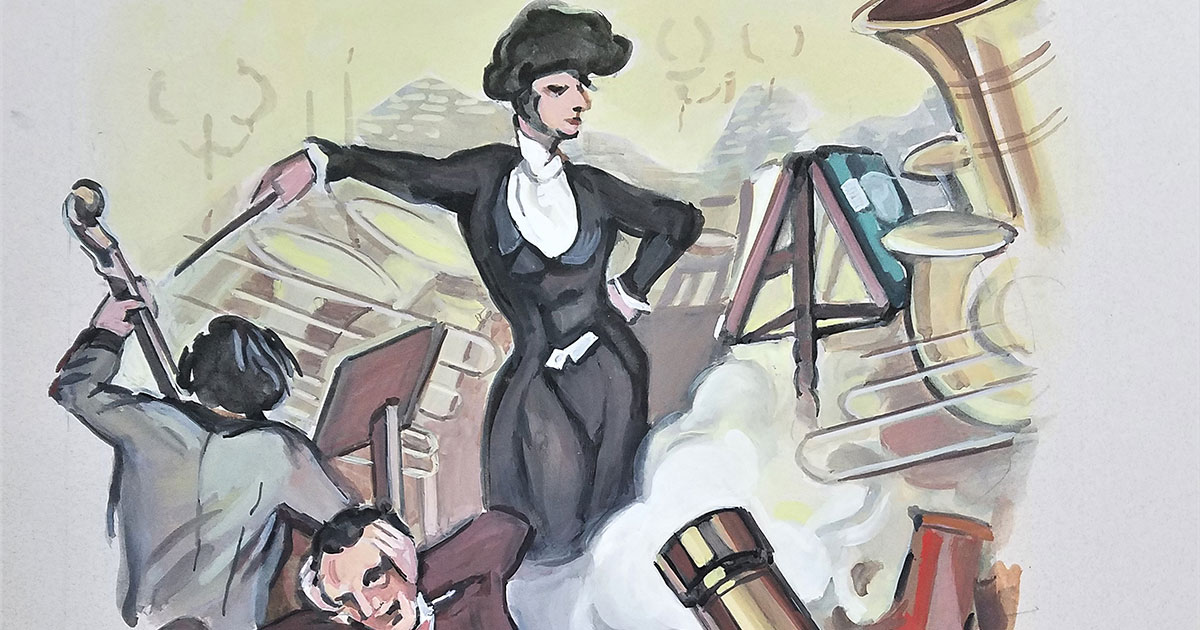How great musicians connect with audiences

LAWRENCE — John Tibbetts’ long career as a journalist gave him entrée to some of the world’s most acclaimed artists and performers. His habit of making watercolor paintings of them and getting them to autograph the work endeared him to them even more.
 And while the movies have always been the University of Kansas associate professor of film & media studies’ first love, music is not far off. Tibbetts’ father was a jazz musician, and he himself has served as a piano accompanist for silent film showings at the American Film Institute, among other places.
And while the movies have always been the University of Kansas associate professor of film & media studies’ first love, music is not far off. Tibbetts’ father was a jazz musician, and he himself has served as a piano accompanist for silent film showings at the American Film Institute, among other places.
So whenever the local classical radio station or the Christian Science Monitor’s radio network asked him to interview a classical musician visiting Kansas City, Tibbetts jumped at the chance. And he kept all of his video and audio tapes and transcripts, which form the basis for his newest book, “Performing Music History: Musicians Speak First-Hand about Music History and Performance” (Palgrave Macmillan, 2018)
Tibbetts includes conversations with 50 world-class musicians, from Kansas City jazz legend Jay McShann to classical pianists Claude Frank and Emanuel Ax to modernist composer Philip Glass.
The words are Tibbetts'; he had co-editing help from William Everett, Curators' Distinguished Professor of Musicology at the University of Missouri-Kansas City, and Michael Saffle, professor of religion and culture at Virginia Tech.
Tibbetts is also the author of “Composers in the Movies,” (Yale University Press, 2005) and “Schumann: A Chorus of Voices” (Amadeus Press, 2010). From 1966 to 1970 he worked for public radio station KANU-FM in Lawrence, and from 1980 to 1992 he was at classical station KXTR-FM in Kansas City, Missouri.
Ax contributed a foreword, in which he likened his contribution to the new book to that of an athlete: “I watch football games, and I watch tennis matches, my two favorite sports,” Ax wrote. “And I welcome any chance to hear a great quarterback talk about what’s happening on the field. That’s instructive on many levels, and I can appreciate what’s going on all the more.”
Tibbetts said that upon reflection, a theme emerged from the interviews – one about how these artists extended themselves toward their audiences using mass media.
“The point of the book was to talk to musicians about how they play, what they play, what instruments they play on, but just as importantly, how do you reach your audiences?” Tibbetts said. “Musicians today can no longer hide behind the platform. They have to get out there into the public, and how they do that? That’s what these interviews all show.”
A generation or more ago, Tibbetts said, many classical pianists would not even speak to their audiences. Ax admits this in his foreword, but he says he now enjoys interacting with concertgoers and showing off a bit of knowledge about the form.
In the digital age, Tibbetts said, artists “can make a video, they can establish some kind of foundation to reach audiences, they can appear on TV, they can do interview segments that are released with recordings. There are a thousand and one ways musicians can utilize media to inform audiences.
“Yes, it helps their career, but people want that now. Look at the popularity of video releases with special features. Now we want to go behind the scenes,” he said.
Tibbetts said about three-fourths of the interviews in “Performing Music History” are with classical musicians, including Garrick Ohlsson, Anne-Sophie Mutter and Christopher Parkening.
The remainder includes a conversation Tibbetts and the late former KU professor of jazz studies Dick Wright had with pianist Jay McShann “talking about Kansas City bebop, the cats and the spook breakfasts,” pianist George Shearing “about aligning classical traditions with his piano jazz – he’s my hero,” and Broadway composer “John Kander talking about life after his partner Fred Ebb.”
“One I am really proud of is with a guy named John McGlinn,” Tibbetts said. “He produced for EMI Records in England an album that is an essential for any music connoisseur, and that is the complete ‘Showboat.’ He found stuff that had not been heard since the pre-Broadway productions. McGlinn was an impassioned soul who believed the whole of American musical theatre was in neglect; its history being abandoned, so he devoted his life to restoring musicals that we take for granted now like ‘Brigadoon’ and ‘Showboat’ that were in danger of disappearing from the public consciousness. I mean literally records being trashed, archives being abandoned to the trash cans.”
Tibbetts is conscious of the privilege he has enjoyed encountering such towering cultural figures.
“Some of my most happy hours in my whole life have been spent listening to these people,” Tibbetts said. “Listening to Gyorgy Sandor talk about being with Bela Bartok, premiering Bartok’s works, being at his bedside when he died. This is a kind of living history, to talk to this pianist who was his student and protégé. People like that connect you with history. It’s not only what they have to say about their work, but what they have to say about the whole history of their medium.”
Tibbetts said many of the artists he interviewed, particularly the pianists, “would play during the interviews. How cool is that? Emanuel Ax can command perhaps $50,000 for a performance, and there I am sitting on stage beside him, and he’s just playing away while he talks. Now I can’t convey that on the page, but if anyone ever wants to listen to the interview tape, there it is. He boogied up a Haydn sonata. It was great.”
Illustration: John Tibbetts’ painting depicting composer Hector Berlioz’s so-called “concert of gunfire” was used for the cover of his new book.